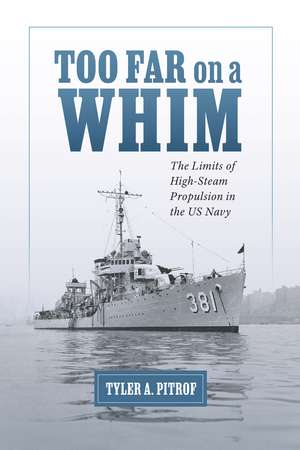Too Far on a Whim: The Limits of High-Steam Propulsion in the US Navy: Maritime Currents: History and Archaeology
Autor Tyler A. Pitrofen Limba Engleză Paperback – 30 apr 2024
In Too Far on a Whim, Tyler A. Pitrof presents a high-spirited revision of the US Navy’s commitment to high-steam propulsion systems, the mainstay of its World War II fleets. Pitrof’s research persuasively demonstrates that in its war against the Imperial Japanese Navy, the US Navy succeeded despite its high-steam propulsion systems rather than because of them.
War with an aggressive Japan and a resurgent Germany loomed in the dark days of the late 1930s. Rear Admiral Harold G. Bowen Sr., head of the US Navy’s Bureau of Engineering, advanced a radical vision: a new fleet based on high-steam propulsion, a novel technology that promised high speeds with smaller engines and better fuel efficiency. High-steam engines had drawbacks—smaller operational ranges and maintenance issues. Nevertheless, trusting its engineers to resolve these issues, the US Navy put high-steam propulsion at the heart of its warship design from 1938 to 1945.
The official record of high-steam technology’s subsequent performance has relied heavily on Bowen’s own memoir, in which he painted high-steam innovation in heroic colors. Pitrof’s empirical review of primary sources such as ship’s maintenance records, however, illuminates the opposite—that the heroism lay in the ability of American seamen to improvise solutions to keep these difficult engines running.
Pitrof artfully explains engineering concepts in layman’s terms and provides an account that extends far beyond technology and into matters of naval hierarchies and bureaucracy, strategic theory, and ego. He offers a cautionary tale—as relevant to any endeavor as it is to military undertakings—about how failures arise when technical experts lack managers who understand their work. Admiral Bowen wielded excessive power because no one else in the US Navy knew enough to countermand him.
Compulsively readable, Too Far on a Whim is a landmark for those interested in naval history and technology but also for readers interested in the interplay between innovation, decision-making, and engineering.
War with an aggressive Japan and a resurgent Germany loomed in the dark days of the late 1930s. Rear Admiral Harold G. Bowen Sr., head of the US Navy’s Bureau of Engineering, advanced a radical vision: a new fleet based on high-steam propulsion, a novel technology that promised high speeds with smaller engines and better fuel efficiency. High-steam engines had drawbacks—smaller operational ranges and maintenance issues. Nevertheless, trusting its engineers to resolve these issues, the US Navy put high-steam propulsion at the heart of its warship design from 1938 to 1945.
The official record of high-steam technology’s subsequent performance has relied heavily on Bowen’s own memoir, in which he painted high-steam innovation in heroic colors. Pitrof’s empirical review of primary sources such as ship’s maintenance records, however, illuminates the opposite—that the heroism lay in the ability of American seamen to improvise solutions to keep these difficult engines running.
Pitrof artfully explains engineering concepts in layman’s terms and provides an account that extends far beyond technology and into matters of naval hierarchies and bureaucracy, strategic theory, and ego. He offers a cautionary tale—as relevant to any endeavor as it is to military undertakings—about how failures arise when technical experts lack managers who understand their work. Admiral Bowen wielded excessive power because no one else in the US Navy knew enough to countermand him.
Compulsively readable, Too Far on a Whim is a landmark for those interested in naval history and technology but also for readers interested in the interplay between innovation, decision-making, and engineering.
Preț: 297.30 lei
Nou
Puncte Express: 446
Preț estimativ în valută:
56.89€ • 58.69$ • 47.47£
56.89€ • 58.69$ • 47.47£
Carte disponibilă
Livrare economică 06-20 martie
Livrare express 19-25 februarie pentru 30.59 lei
Preluare comenzi: 021 569.72.76
Specificații
ISBN-13: 9780817361402
ISBN-10: 0817361405
Pagini: 232
Ilustrații: 15
Dimensiuni: 152 x 229 x 18 mm
Greutate: 0.4 kg
Editura: University Of Alabama Press
Colecția University Alabama Press
Seria Maritime Currents: History and Archaeology
ISBN-10: 0817361405
Pagini: 232
Ilustrații: 15
Dimensiuni: 152 x 229 x 18 mm
Greutate: 0.4 kg
Editura: University Of Alabama Press
Colecția University Alabama Press
Seria Maritime Currents: History and Archaeology
Notă biografică
Tyler A. Pitrof is a historian in the Public History and Education Team in the histories and archives division of the Naval History and Heritage Command.
Recenzii
“Tyler Pitrof’s meticulous scholarship highlights an important aspect of military innovation: the dangers of relying on single-source expertise when fielding new technologies like high-steam propulsion. This work is a cautionary tale that goes beyond mere history and is applicable today, especially in light of the Titan maritime disaster in the Atlantic.”
—John T. Kuehn, professor of military history, US Army Command and General Staff College
"Too Far on a Whim: The Limits of High-Steam Propulsion in the US Navy is ground-breaking work in what is obviously an under-served aspect of U.S. Navy history. . . Pitrof’s narrative is well organized, and his writing is crisp and concise. . . It will resonate beyond naval historians to include historians of science and technology, and lay audiences."
—Craig Felker, author of Testing American Sea Power: U.S. Navy Strategic Exercises, 1923-1940
—John T. Kuehn, professor of military history, US Army Command and General Staff College
"Too Far on a Whim: The Limits of High-Steam Propulsion in the US Navy is ground-breaking work in what is obviously an under-served aspect of U.S. Navy history. . . Pitrof’s narrative is well organized, and his writing is crisp and concise. . . It will resonate beyond naval historians to include historians of science and technology, and lay audiences."
—Craig Felker, author of Testing American Sea Power: U.S. Navy Strategic Exercises, 1923-1940
Descriere
Argues that the US Navy’s commitment to high-steam propulsion for its World War II fleet was a tactical, technological, and bureaucratic failure











